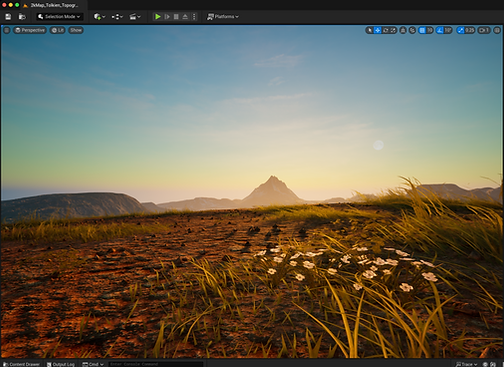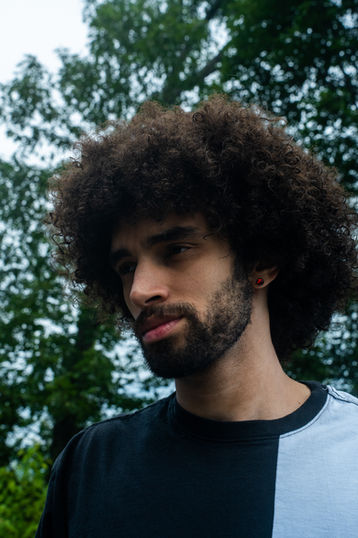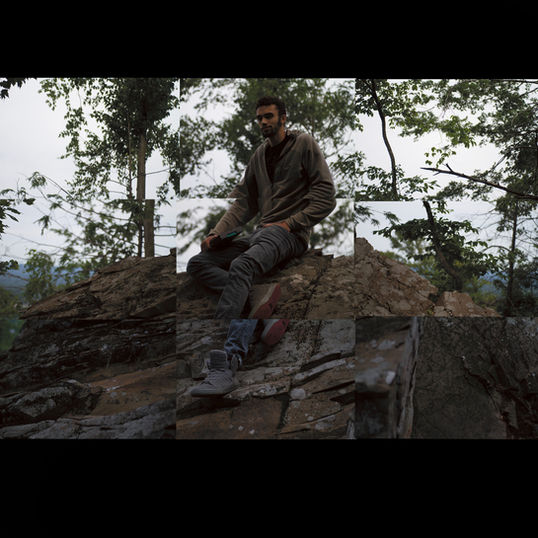STORY



I: Sankofa
I was born into the legendary Neville family of New Orleans, my father Charles Neville, of The Neville Brothers, provided me with a storied, world class musical education from a young age, which to this day grounds all of my work in a deep sense of history.
While being born into a musical legacy would usually typecast you to be a musician, my passion lay beyond the bounds of the equal temperament system. After years of pushing my musical expression and theoretical capabilities to their limits, I realized what I was envisioning, was visual.
So taking advantage of the isolation the pandemic forced us all into, I plugged my brain directly into the internet and absorbed all the knowledge I could about the mystical world of filmmaking.
5 years later I have filmed, edited, color corrected and scored more filmic works than I can count.
Still though, there were things I was seeing that I couldn't find through my lenses...
II: A Dive Into The 4th Dimension
Having been an avid gamer my whole life, video game technology has always fascinated me, and beginning my voyage into the world of filmmaking right at the time the technology of The Volume was coming onto the scene lit the ember of creativity that now fuels all of this '4th dimensional work' from the start. Specifically, with many of the biggest budget and most high rated blockbuster shows and films of the past 5 years incorporating The Volume (Which uses Unreal Engine 5, the same software I exclusively work in) I was constantly pondering what the difference really is from "real" and virtual filmmaking? Because the technology had gotten to a point where you could hardly tell the difference, though I always felt like the aforementioned big budget productions were tying themselves to the "real" world when they could harness the full potential of the virtual world by detaching themselves from those physical constraints all together. Though understandably a step into the void of virtual space is a little daunting, and best taken without the expectation of big budgets and balance sheets looking over your shoulder, as a matter of fact, to achieve the state of virtual-physical phase necessary to take that step, one can't be tied by any of those real world lines.
So after pushing my filmic creativity to its limits with physical camera technology, and all the while trying to find a way to seamlessly synthesize my various disparate creative mediums together. I had a thought, what if I didn't have to think about negative fill, or time of day, or how much battery my drone had, or... what if I could delete the sun and still have sunlight at the exact angle, color! and Character of my choosing. Well that would mean the capacity to capture an 'Emotional Aesthetic' or 'Character' would be limitless, and that the margins we push so hard for in the 'real world' to hopefully get one good take, with the time and budget we have, would become the noise floor for a noiseless sensor, a sensor who can pull 256000 ISO, an IMAX lens that can be 70mm wide but have the sensor 2 inches away from the grass.
Wait, isn't that physically impossible?
No, it's unreal, but unreal is real now.
So, with this realization I took the first step out of the door to our reality, and into the admittedly weird, but creatively limitless virtual one.
So let me introduce the cast of characters and explain all of the software, hardware, creative, and technical components to my 4th dimensional VR work, as well as give a good explanation of how exactly it's 4th dimensional.
Character 1: The Metahuman Creator (Unreal Engine)
Just before diving into the virtual realm, Unreal Engine released a fascinating new tool, The Metahuman Creator, a tool that allowed you to make virtual humans with incredibly lifelike precision, but unlike the makeup or casting departments of traditional film, you can adjust your characters look to fit the story exactly, or even craft the story around their created character in a paradoxical dance of 'which was first?' Story or Character? Now this part I can't explain, but I will credit my dad being a talented portrait painter and my grandmother being a gifted landscape painter, but through all of my technical understanding and capability, I was able to wield the dials and sliders of the metahuman creature like a paint brush, a brush though that exists in a quantum state, where any and every possibility is possible, but you can try them all.
The foundation of a great story is a create character, but what if the character is the story? With a few initial characters created I came to fascinating realization, the perfect synthesis of music and visual mediums I had been searching for finally had a context, because in all of my work creating physical film and especially scoring physical film, I learned one thing, the music is what defines the emotional subtext of the characters, and without it they are almost a blank canvas, unsure of how to be in the story they inhabit, so here where your story is a character, music becomes the most important piece to contextualize their identity, while also creating a temporally locked narrative foundation.
Character 2: Logic Pro X
When I was 15 my dad gifted me Logic Pro for my birthday, and let's just say I was not a pro. Many years later, after he left this world, I searched for myself, my meaning, and my voice all within the monochrome tones of the Logic Pro X UI. As though it were Logic itself reaching out to give me a guiding hand, I found it. Because my character as a musician exists 4th dimensionally, coming from a heritage of 'real' music, with my Dads band the Neville Brothers being in my admittedly biased opinion one of the most 'human' and emotionally engaging bands ever, but my own character and voice lying strictly within the binary boundaries of digital music creation, I existed in two times at the same time. What I found was a way to synthesize those two characters together, having pushed my physical musicianship through studying jazz technique and theory with my dad, and then playing on my own to hone my chops even further, while also trying to integrate those skills and traditions into the binary world of digital music creation, and failing. Until the world of film scoring got me close, and the aforementioned task of capturing character through the digital musical medium connected those two states somewhat, but this, the task of capturing human character for a character that was purely digital, was going to be lossless, a compression ratio which yielded no artifacts. So channeling the musical power of all of my ancestors and the larger creative cultural ancestry they represent I tried, did I succeed? you'll have to tell me. Though what I did on a technical level does seem like it accomplishes that goal, because each piece of music for these characters is "Funky" per the musical definition of the word funk which I would define as being out of sync or time, but in a manner which enhances the character of the piece, doing that with humans is pretty easy, doing that with a computer is maddeningly precise, and almost impossible. Intentionally throwing every note off of being 'perfectly' on beat so that everything has that funk characteristic, but unlike human funk, it is engineered, designed, crafted precisely outside of time to give the effect of flowing through time seamlessly the way a band does.
This is where my interpretation of the 4th dimension began to come into the mix, as you may be able to discern.
Character 3: Unreal Engine
Now with characters, both 'physically' through their metahumans, and emotional aesthetically through my "future funk" theme I created for them established, the pieces were beginning to come into place. Though the pieces were currently just floating in space, because I had yet to figure out the correct setting for these stories, or moreover the correct way to represent this theme of Character≤≥Story∞Character. I knew that these worlds lay within the infinite possibilities of Unreal Engine, I just wasn't sure what filmic technique or style was right to capture such a new story format, the answer was pretty obvious, a new one. That 'new' medium, is VR, a medium capable of transporting you anywhere, but with a technical barrier to entry that excited me more than anything I'd ever encountered before, so I plugged myself back into the internet and figured out how you could render 360º video out of Unreal (it is insanely complicated so I'm not going to describe it at all) that was the simple part though, the real question was how on earth do you direct the eye (where people are looking, and therefor the intelligibility of the story) when you can look anywhere? Do you put up a sign that says "look over here" or make the 'story' a really bright color? No,
the answer is you can't,
so these stories have to exist in 360º, but still provide an 'anchor point' to be able to follow and look away from, not unlike driving or walking down a road, knowing where you're moving and why, but being able to look all around, and ponder the stories that lay behind each window, or shrouded in fields of grass. So that's exactly what I did, developed a framework to create a "frame" for 360º space, I call it The Azimuth, and it is basically just a path which the camera (you) travels down, and with our brains being very used to Azimuth oriented motion and travel, the experience of being moved around when you're not actually moving in this manner becomes understandable, and allows you to creatively take in all that's around you. There's one problem with that though, no matter how interesting an azimuth may be, traveling down it in a straight line at a fixed speed for a fixed amount of time is not very exciting, and it is in 'excitement' or more specifically the tension and release dynamic curve which defined a narrative progression, that character and story exists.
If you can do anything in virtual reality, couldn't you make time not go straight?
Yes, and also, the fundamental drawback of all 360 narrative media is that you can't possibly look at everything if you watch it once, so to get the full 360º experience you would have to pass through that narrative multiple times, but what could possibly justifiy this temporal loop? The one thing, that for its millennia of existence has in my opinion always manipulated the perception of time, music. Not unlike Kool Herc when he first cut the breaks out of tracks for his sisters birthday party founding hip hop, if you stitch and glitch time, all while maintaining a tempo, our brains feel like the linearity of time still exists, even when it really doesn't. So with a few minor adjustments to the musical pieces I enabled them to loop infinitely, by combining the ultra precision of digital music production, and the human funk and flow of the human musical tradition. With that I had it, a temporal implement, a tool to define the speed, flow, rhythmic contour and character of time itself. So back to the virtual world of Unreal Engine, I realized that the true state of character if looked at non linearly but overlayed on a linear canvas, is quantum, we don't exist in any one state of emotion, we exist in all of them, just at different times, though if the goal is to capture the 4th dimensional state of pure 'character' it must be tapestry of multiple states of character, presented 4th dimensionally at the same time. So in my Azimuth design process I created multiple versions of the azimuth, each one to represent a different shade of that characters character, and using the temporal trickery of music, and the infinite loop ability that grants us played against the infinite perspective 360º space gives us, I found myself able to jump between times, positions, speeds, and all other manner of states, within or upon the azimuth, and after creating the first full NAE (Narrative Azimuth Experience) I saw that it actually worked, that the simple combination of linear framing and movement balanced against the infinite perspective and creative possibility granted by 360º rendering in Unreal Engine, created an experience unlike anything else, a 4th dimensional experience.
As this story has aptly illustrated, it seems like in my dimorphous nature being tethered to the drum beats of the ancient past, but pulled to the digital glow of the future, am the 4th dimensional character who'm all of these characters exist through.
Or I'm just a crazy artist and this is my attempt to mathematically explain art which isn't possible.
III: But Why Though?
With all of that techno-creative nonsense out of the way, we are left with a fascinating resultant, a creative work which captures character with a level of precision impossible to do in the physical world, but as a result of how much goes into just making it 'work' at all, there is no space for a literal narrative. Meaning there is no language, just the universal language of emotion and the universal theme of character. So with that previously impossible creative state harnessed, and a medium developed which fully immerses the viewer in these experiences, but is completely accessible to any all people of all backgrounds, languages and characters. The ability to universally connect people, both through the incredible logistical and economic flexibility of a purely digital format, being presented in a purely digital medium (VR), but also through a narrative who's only theme, is character itself, which in us all being characters is the only universally accessible theme, therefor creating the possibility for people from any and everywhere in the world to share in the same exact experience.
In a world more divided than ever, and with digital society often being ambiguous at best in it's social and cultural impact, something which harnesses the full potential and promise of digital society, for the purpose of connecting people in a universal manner which is impossible in any other way, might just help bring us all to understand that in the end, we are all characters in the same story.








To chat with my AI agent click this image ^^






















